A perfect garden lies beyond a fence bordering a track I frequently walk down. Called Rivendell, the name of home of the Elven King in Tolkein’s Lord of the Rings, the garden achieves the same mystical stillness. At Rivendell, Frodo Baggins recovered from his injuries. One gets the impression that this Rivendell is a place of isolation and calm worthy of it’s name.
Little did I know as a dashed down the track to watch my son play rugby, that this delightful garden lay beyond that fence. Were in not for the National Garden Scheme, and the fact that the owners open their garden to the public once a year, I would still not know.
Subtle structure that showcases the plants
Arranged around a central lawn a series of paths snake around generous beds full of herbacious perennials, shrubs and small flowering trees.
The garden has few straight lines, the exception being a patio by the house and a central path, which dissects the lawn, and which is dotted with delightful alpines including a saxifrage reminiscent of a treasure island.
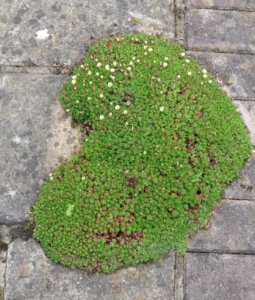
Gently spreading saxifrage set in cracks in a path and reminiscent of a treasure island.
A garden for all seasons
When I ask my friends what they most want in a garden, almost all say something that looks good in all seasons. Gardeners know that this a difficult thing to achieve, particularly in a small or medium sized garden where interest is required at every turn.
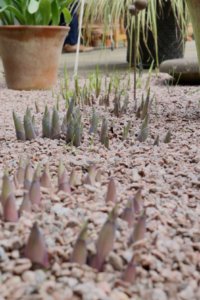
Hostas pushing their way through gravel – sure to put on a spectacular summer show
The owners of Rivendell have achieved this. Opening their garden in spring is a choice they make as there are so many competing attractions for visitors in the summer months. Fling your doors open in Spring and there are many punters hungry for a visual feast at the end of the long dreary winter.
It is obvious walking around Rivendell that it would be equally beautiful in summer, autumn and even winter. Draw your eye away from the spring beauties and you can spot roses just coming into leaf. Hostas push their way up through layers of gravel, their leaves tightly furled into an aggressive pike. The leaves of bearded irises stand spear-like in the beds and the coils of tightly furled ferns languish hidden, but poised to break out.
The owner described to me how the opening in 2017 followed a week of warm sunshine and temperatures on the day of opening reached 60 degrees. Tulips were in full bloom and even the first roses had made an appearance.
Of course I would love to see this particularly garden at any time of year but I do feel I learned much from the spring plant combinations and how to layer interest for all seasons.
Daffodils to shout about
Daffodils, in creamy and yellow shades are showcased in large clumps throughout the garden. The owner has wittled down her choices over the years and found varieties which stand tall above the emerging foliage of other perennials and don’t flop.
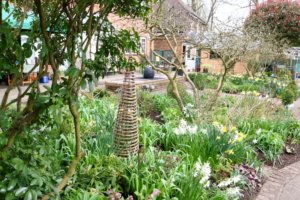
Narcissus ‘Thalia’ and ‘Wisley’ shine out from the layered planting and stand proud of the emerging perennials
The popular Narcissus ‘Thalia’ is much in evidence but equally beautiful was a two tone Narcissus ‘Wisley’, a variety which opens yellow but where the petals then fling themselves backwards and turn creamy white. The trumpet remains solid yellow.
Further yellow is added by Narcissus ‘St Patrick’s Day’. Presumably this is often in flower around the middle of March but a cold winter has held it back so it was still going strong in mid April.
Hellebores and Dicentra
Hellebores were also much in evidence, in shades ranging from dark mauve, through speckled pink to white. Hellebores have had a great year, with the colder weather prolonging flowering by several weeks. Again, fantastic varieties have been chosen, forming healthy upright clumps.
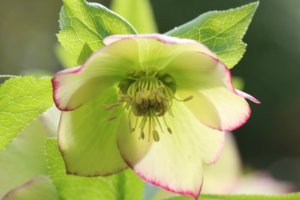
Hellebore – a pictoee variety with pink tinged flowers
My favourite variety at Rivendell was a ‘Picotee’ type with ivory petals edged in rose pink. Even on a dull day this flower appeared to shine.
A lovely combination was a dark plum Hellebore alongside Dicentra Spectabilis ‘alba’, a pure white form of the Bleeding Heart flower.
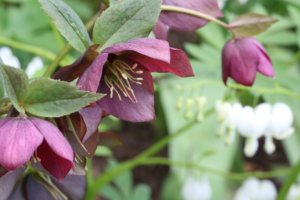
Dark mauve Hellebore alongside pure white Dicentra.
A woodland area
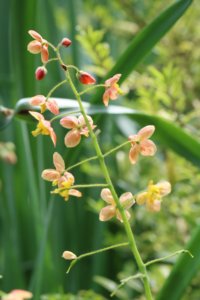
Delicate orange flowers of Epimedium x warleyense (Ellen Wilmott)
Towards the shadier end of the garden, a gravel path snakes behind a summer house and through beds crammed with shade-loving species such as epimedium, ferns, erythronium and euphorbia. Particularly notable were the delicate flower spikes of peachy-orange Epimedium x warleyense (Ellen Wilmott) A few Snakes-head Fritillaries fritillaria meleagris and pink Polyanthus were woven in between.
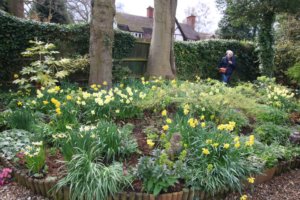
A woodland area under the shade of tall trees showcases, daffodils, epimediums, and ferns
The leaves of snowdrops and Cyclamen hederifolium were still in evidence, a sign that even in the depths of winter this garden has something to shout about.
A passion for plants
It is easy to see when a gardener loves their plants and like any gardener’s garden there is a ‘waiting room’ at Rivendell where plants have been carefully potted up and labelled.
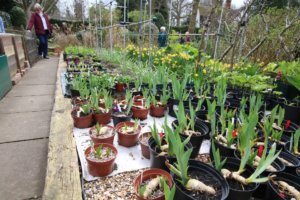
The plant ‘waiting room’ at Rivendell with a wide selection of Irises.
These Irises caught my eye lined up waiting for a space to become available. The owner divides her plants and grows many from seed, although the pulmonarias she admits to finding hard to propagate from seed. They don’t need help though and she lets them pop up around the garden, where they thronged with bumble bees keen for early season nectar.
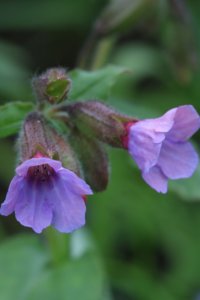
A delightful purple pulmonaria – popular with bees
The National Garden Scheme
Rivendell’s owner is involved with the NGS in Buckinghamshire and the garden is one of 3,643 open to the public across the country under the scheme. Whilst the programme is still fondly referred to in the gardening community as the ‘Yellow Book’ scheme, It’s well worth checking out their fantastic website.
This provides much more information than is possible in the yellow book itself, lovely pictures to help you decide which to visit, and even a post-code finder to narrow down the options close to you.
The money raised through the NGS goes to several charities and an incredible £55 million has been raised over the years.
Further pictures of Rivendell can be found by following this specific link to the NGS website.
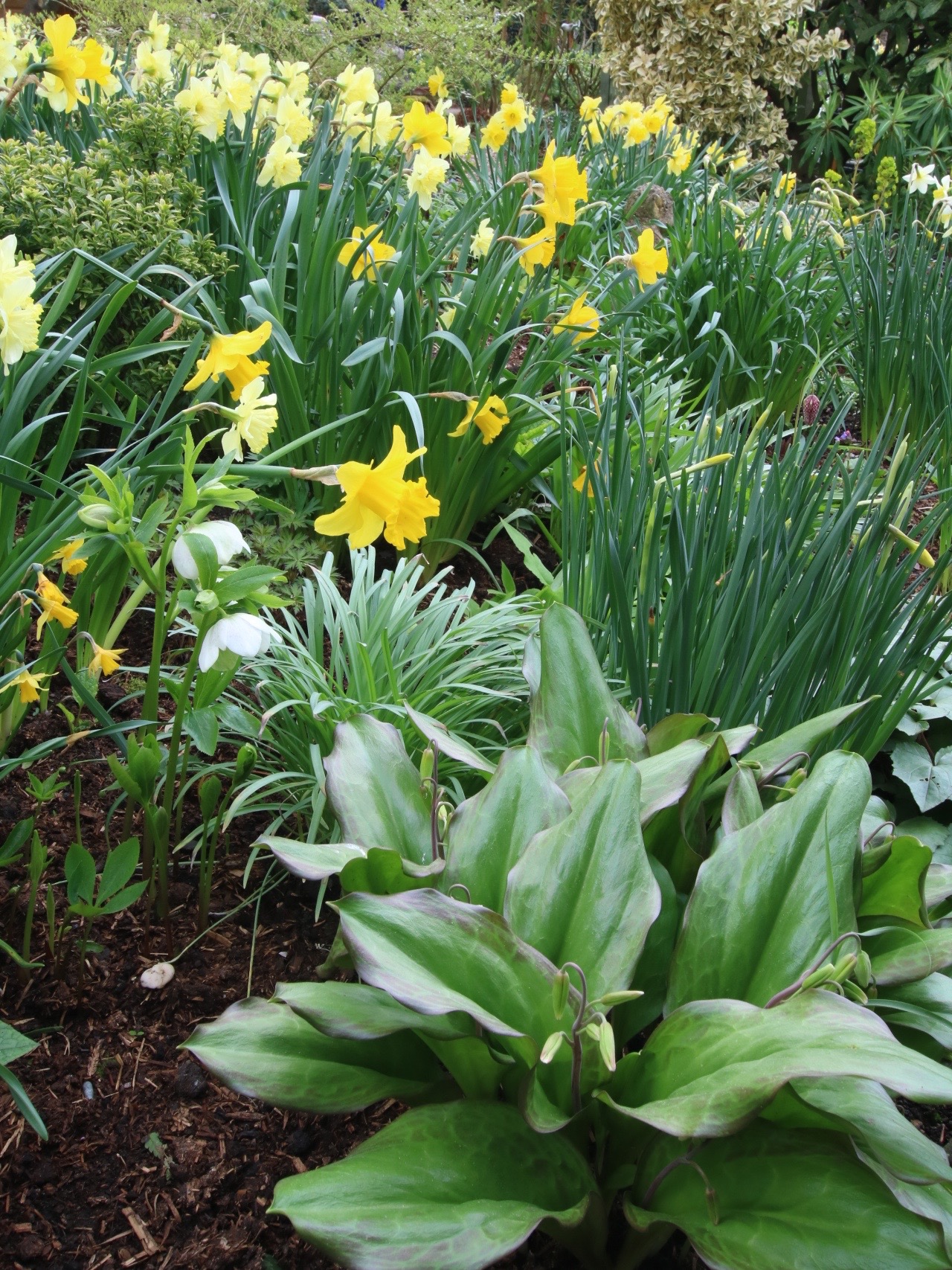
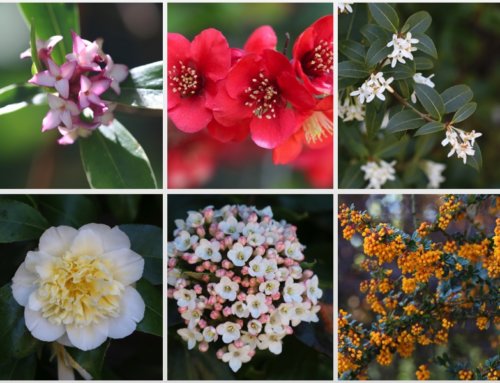
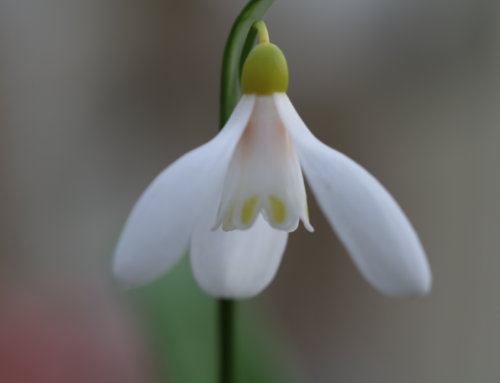
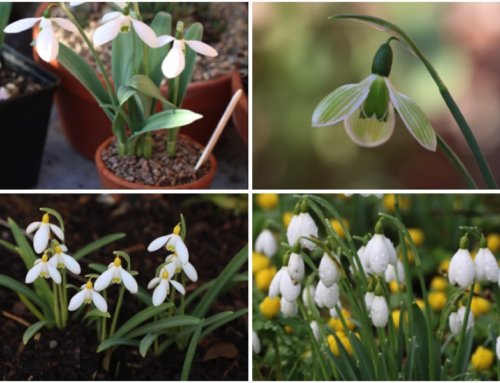
Could only find Rivendel (. One l )on NGS website and not open in Spring. Would like to visit. Help!
Hi Jan, Yes I just looked and couldn’t find it either. I’ll try and find out for you and let you know. Katharine